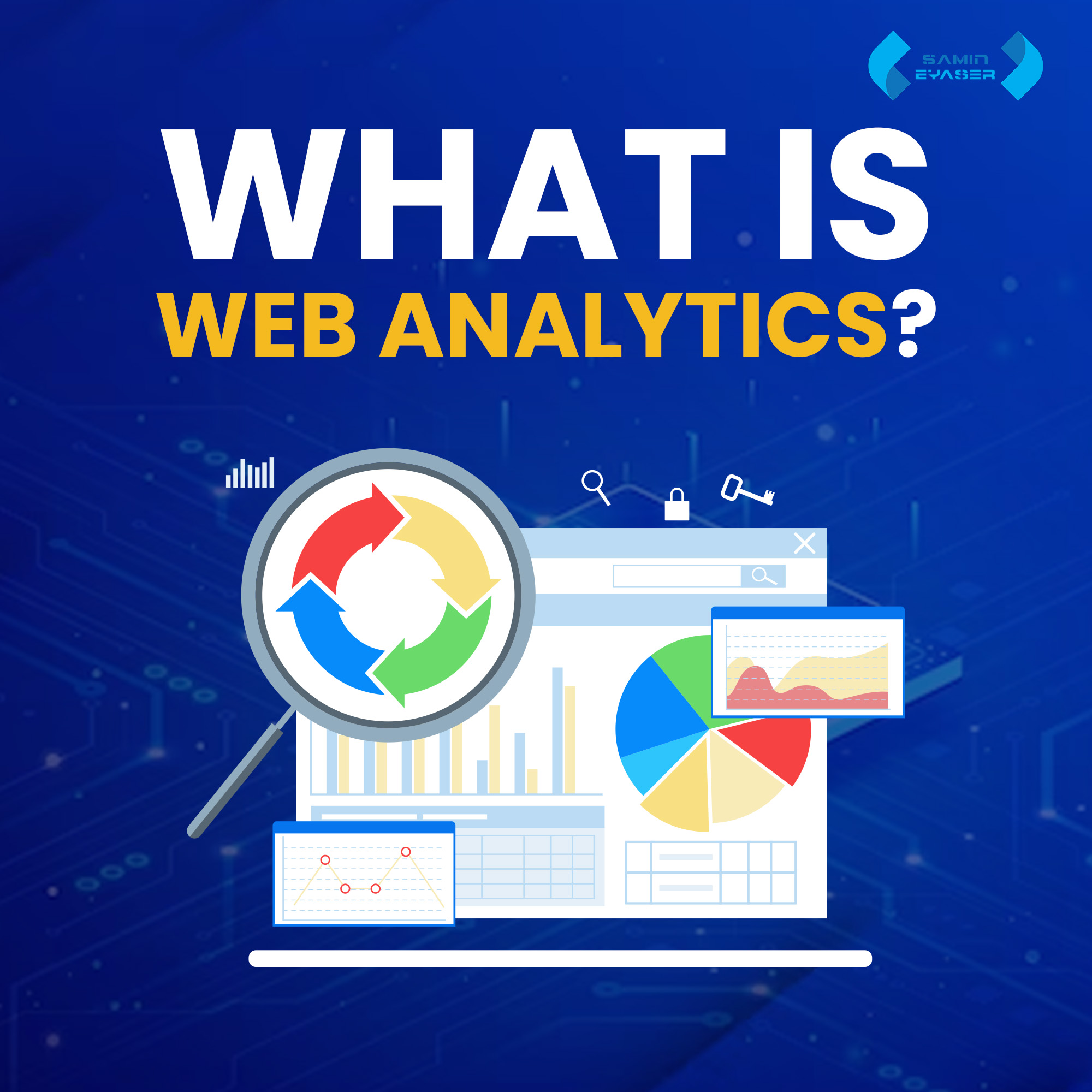Web analytics is the process of collecting, analyzing, and interpreting data related to online user behavior. In the dynamic landscape of the internet, businesses and organizations use web analytics to gain valuable insights into the performance of their websites. By examining metrics such as website traffic, user engagement, and conversion rates, companies can make informed decisions to optimize their online presence. Tools like Google Analytics play a pivotal role in this process, providing a comprehensive view of how users interact with a website. In essence, web analytics empowers businesses to understand their audience, enhance user experiences, and tailor digital strategies for maximum impact in the ever-evolving online environment

What is Web Analytics?
Web analytics is the systematic process of analyzing, measuring, and interpreting user behavior on websites. It involves the collection, review, and reporting of data to understand and optimize web usage. This practice provides valuable insights into various aspects of a website, including user engagement, page popularity, and overall performance. The ultimate goal is to enhance the website user experience and make informed decisions to improve its effectiveness and relevance in the digital landscape. In essence, web analytics acts as a digital detective, unraveling the mysteries of online interactions to help website owners tailor content, boost return on investment, and better understand their audience
Understanding Web Analytics Basics
Web analytics is the process of collecting, reporting, and analyzing data related to website usage. It focuses on measuring and understanding user behavior to optimize web performance and enhance user experience. This practice involves identifying key metrics aligned with organizational goals, using data to drive decision-making, and gaining insights into how a website is performing. In essence, web analytics provides a comprehensive view of website interactions, offering valuable information for businesses to make informed decisions and improve their online presence.
Choosing the Right Web
Selecting the right web analytics tool is crucial for effective digital marketing and SEO optimization. When choosing a tool, consider factors such as business objectives, pricing, user interface, advanced analytics capabilities, and integration possibilities. Making a list of mandatory features, understanding mobile requirements, and identifying technical needs are key steps in the decision-making process. Additionally, evaluating the tool’s compatibility with your business needs and assessing its ease of use are fundamental aspects of the selection process. Prioritize requirements, consider features, and align the tool with your specific needs to ensure optimal performance and insights. Keep in mind that the right web analytics tool is the linchpin for unlocking valuable data and making informed decisions in the digital landscape.
The Google Analytics Symphony
Google Analytics, the virtuoso of web analytics tools, provides a comprehensive view of your digital stage. Learn how to leverage its power for maximum impact
Setting Up Google Analytics
Setting up Google Analytics involves a series of steps to gather valuable insights into website performance. The process typically includes creating a Google Analytics account, setting up Google Tag Manager for streamlined tag management, configuring analytics tags, and defining goals for meaningful data tracking. Beginners can explore the basic features through courses like “Google Analytics for Beginners,” covering account creation, tracking code implementation, report analysis, and goal setting. Various tutorials, such as the one by W3Schools, offer step-by-step guidance on implementing Google Analytics on both websites and mobile apps. Whether optimizing for a website or mobile app, a well-configured Google Analytics setup is essential for informed decision-making in digital strategies.
Creating an Account: Prelude to Analytics
Creating a Google Analytics account is the initial step in harnessing the power of web analytics. Whether setting up for the newer GA4 or the Universal Analytics (UA), the process involves creating an account, providing a name, configuring data-sharing settings, and linking it to your website or app. The user-friendly interface allows easy account creation by entering details like account name, web address, and business information. After creating an account, users can log in, access the Admin section, and initiate the setup process, which may include additional steps such as creating goals and implementing tracking codes. Overall, establishing a Google Analytics account serves as the vital prelude to unlocking a wealth of data and insights about online user behavior.
Installing Tracking Code: The Analytics Overture
Installing tracking code is a crucial step in leveraging web analytics, and different platforms provide distinct methods for this task. For instance, to import cost data from Overture into analytics platforms like Urchin, users can log into their Overture account, click the Reports tab, and follow the designated steps. On the Google Analytics front, installing the tracking code involves accessing the Tracking Info section, clicking on Tracking Code, and obtaining the code necessary for website integration. Additionally, for mobile app tracking, steps include enabling app install tracking, updating the Analytics SDK, and configuring Custom Campaigns within the Google Analytics account. Each platform’s unique approach ensures seamless integration, enabling users to gain valuable insights into user behavior and interactions
Configuring Goals and Events: Crafting Your Symphony
Configuring goals and events is akin to crafting a symphony in both professional and personal domains. In the professional realm, it involves setting specific events or milestones, such as completing a purchase or achieving a specific task, to drive user engagement and success . This parallels the idea of orchestrating a harmonious path to excellence, where adaptability and conflict resolution play crucial roles in navigating diverse team settings . Drawing insights from successful event experiences, building a strong vision becomes essential, much like the process of configuring goals to drive success . In essence, the symphony of configuring goals and events involves strategic planning, adaptability, and a clear vision for success
Interpreting Analytics Data
Interpreting analytics data is a crucial step in extracting meaningful insights. It involves analyzing and presenting data to draw informed conclusions. Effective interpretation requires asking relevant questions about the data’s relationship to the investigative goal. Visual aids and storytelling are powerful tools to communicate findings, making the interpretation process more accessible. Assembling necessary information, isolating relevant inputs, and providing actionable solutions are key steps in the process. While there’s no one-size-fits-all approach to analyzing and interpreting data, employing diverse analytical methods is essential for arriving at relevant and accurate conclusions
Optimizing Website Performance
Providing a flawless user experience on websites requires optimizing their performance. Various strategies can be employed, including image optimization, minifying and combining files, leveraging browser caching, and utilizing Content Delivery Networks (CDNs). Regular site audits, prioritizing potential fixes, and evaluating hosting providers are essential steps in the optimization process . Additionally, optimizing above-the-fold content and following critical rendering path practices contribute to improved website speed
Utilizing Analytics for SEO Enhancement
Utilizing analytics is crucial for enhancing SEO performance. Google Analytics, for instance, provides valuable insights into website performance, audience behavior, and content optimization . By leveraging data from analytics tools, businesses can identify keywords, track conversions, and spot areas for improvement . SEO analytics guides, such as the one on SEMrush, offer a comprehensive 4-step approach to effectively track and evaluate key data for optimizing websites . Implementing these strategies allows website owners to refine their SEO campaigns, capitalize on opportunities, and ensure better overall performance
The Role of Web Analytics in Marketing Strategies
Web analytics plays a pivotal role in shaping effective marketing strategies. It provides valuable insights into customer behavior, preferences, and attitudes, enabling businesses to tailor their campaigns to target audiences . By understanding who the customers are and their interests, digital marketers can refine their approaches for better engagement . Moreover, the data obtained through web analytics is essential for developing a comprehensive digital strategy, optimizing websites, and making data-driven decisions for business growth . In today’s digital landscape, the importance of investing in data analytics, as highlighted by marketers, is evident in tackling the challenges companies face and ensuring successful marketing endeavors
Challenges in Web Analytics
Web analytics plays a pivotal role in shaping effective marketing strategies in the digital age. By scrutinizing online user behavior, businesses can gain valuable insights into the preferences and actions of their target audience. This data-driven approach allows marketers to optimize website performance, understand customer journeys, and tailor content to meet specific needs. Through tools like Google Analytics, businesses can track key metrics such as website traffic, conversion rates, and user engagement, enabling them to make informed decisions to enhance the overall online experience. The real-time nature of web analytics empowers marketers to adapt quickly to changing trends and consumer behavior, ensuring that marketing efforts remain relevant and impactful in an ever-evolving digital landscape. In essence, web analytics serves as a compass, guiding businesses towards data-driven decisions that maximize their online presence and marketing effectiveness
Future Trends in Web Analytics
The future of web analytics holds exciting possibilities as technology continues to evolve. Machine learning and artificial intelligence are poised to play a significant role, enabling more advanced predictive analytics and personalized insights. The emphasis is shifting towards a holistic understanding of customer journeys across multiple touchpoints, transcending traditional website metrics. As privacy concerns rise, there’s a growing focus on privacy-centric analytics, with an increased reliance on first-party data and cookie-free tracking methods. The integration of voice search and the Internet of Things (IoT) data into analytics platforms will provide a more comprehensive view of user interactions. Real-time analytics will become even more instantaneous, allowing businesses to adapt swiftly to changing trends. The future trends in web analytics revolve around a more sophisticated, ethical, and user-centric approach, empowering businesses to make informed decisions in an increasingly dynamic digital landscape
Common Mistakes to Avoid in Web Analytics
In the realm of web analytics, avoiding common mistakes is crucial for deriving accurate and meaningful insights. One frequent error is neglecting to set clear goals and key performance indicators (KPIs) before diving into analytics. Without predefined objectives, it becomes challenging to measure success or make informed decisions. Another common misstep is overlooking data quality and accuracy. Relying on incomplete or inaccurate data can lead to misguided conclusions and flawed strategies. Additionally, the oversight of not considering the context behind the data often occurs, limiting the depth of understanding. Failing to stay updated on changes in analytics tools and industry trends is another pitfall, hindering the ability to leverage the full potential of available resources. Lastly, ignoring user privacy regulations can result in ethical and legal consequences. By avoiding these pitfalls, businesses can enhance the reliability of their web analytics efforts and make data-driven decisions with confidence.
Conclusion
web analytics is a powerful tool that empowers businesses to harness data-driven insights for informed decision-making in the digital realm. It involves the collection, analysis, and interpretation of online user behavior to understand website performance and customer interactions. By scrutinizing key metrics, businesses can optimize their online presence, enhance user experiences, and shape effective marketing strategies. The evolution of web analytics continues to be shaped by technological advancements, with trends such as artificial intelligence and privacy-centric approaches paving the way for a more sophisticated and ethical use of data. As businesses navigate the dynamic digital landscape, a comprehensive understanding of web analytics remains instrumental in staying competitive and relevant in the ever-evolving online ecosystem.
Frequently Asked Question
Q1.What is the primary purpose of web analytics?
Ans: Web analytics serves to track and analyze user behavior on a website, providing insights to enhance digital performance.
Q2.How often should I check my analytics data?
Ans : Regularly monitoring analytics is crucial. Depending on your website’s traffic, weekly or monthly checks are advisable.
Q3.Can I use multiple web analytics tools simultaneously?
Ans : Yes, you can. Many businesses use a combination of tools for a more comprehensive understanding of their online performance.
Q4.Are there any free web analytics tools available?
Ans : Yes, Google Analytics is a powerful and free web analytics tool. It provides a robust set of features for users.
Q5.Is web analytics only for large businesses?
Ans : No, web analytics is beneficial for businesses of all sizes. It helps in understanding audience behavior and optimizing digital strategies.
The Visiting our website

